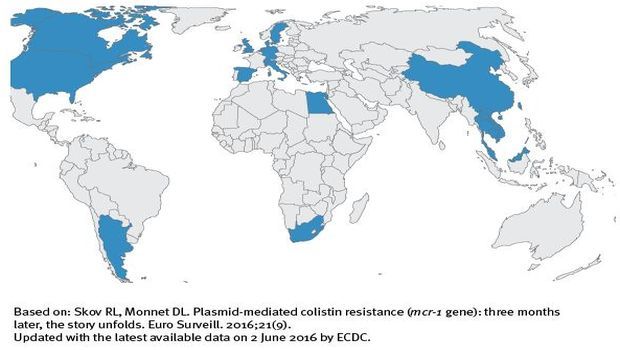ECDC Rapid Risk Assessment Outlines Actions to Reduce the Spread of the mcr-1 Gene
The recently recognized global distribution of the mcr-1 gene poses a substantial public health risk to the EU/EEA, asserts the European Centre for Disease Prevention and Control (ECDC). The gene is widespread in several continents and has been detected in bacteria isolated from multiple different sources such as food-producing animals, food, the environment and humans.


The recently recognized global distribution of the mcr-1 gene poses a substantial public health risk to the EU/EEA. Based on: Skov RL, Monnet DL. Plasmid-mediated colistin resistance (mcr-1 gene): three months later, the story unfolds. Eurosurveillance, 2016;21(9).
The recently recognized global distribution of the mcr-1 gene poses a substantial public health risk to the EU/EEA, asserts the European Centre for Disease Prevention and Control (ECDC). The gene is widespread in several continents and has been detected in bacteria isolated from multiple different sources such as food-producing animals, food, the environment and humans.
This new mechanism of resistance to colistin is of exceptional public health concern because it further limits treatment options in patients with infections caused by multidrug-resistant (MDR) Gram-negative bacteria, and also because it is a highly mobile type of drug resistance (the gene is on a plasmid) that can spread more easily between bacteria.
MDR Gram-negative bacteria, including carbapenem-resistant Enterobacteriaceae strains that acquire the mcr-1 gene, remain susceptible to only a few antimicrobial agents, which means that infections caused by these strains are very difficult to treat and result in excess mortality. As the development of new antimicrobials is unlikely to provide a solution anytime soon, it is crucial to take measures to control the spread of mcr-1 and thus protect the activity of colistin.
Although there are still major information gaps, relating to the current prevalence of colistin resistance in human clinical isolates in the EU/EEA, as well as to the historical and current prevalence of colistin resistance due to the mcr-1 gene, the issue of further spread of mcr-1 needs to be taken seriously and be carefully monitored by EU/EEA countries.
Andrea Ammon, ECDC acting director, said, "The spread of the mcr-1 gene represents another step toward pandrug resistance and infections that would be very difficult, if not impossible, to treat. Further spread would increase the morbidity and mortality in patients undergoing advanced medical procedures, thus having a profound effect on the practice of medicine."
In its rapid risk assessment, ECDC outlines a number of actions that need to be considered to reduce identified risks of mcr-1 spread. These include improved laboratory methods for colistin resistance testing and mcr-1 detection, improved surveillance, options for appropriate clinical management, and actions to prevent transmission in healthcare settings as well as in the community.
Source: European Centre for Disease Prevention and Control (ECDC)
Show, Tell, Teach: Elevating EVS Training Through Cognitive Science and Performance Coaching
April 25th 2025Training EVS workers for hygiene excellence demands more than manuals—it requires active engagement, motor skills coaching, and teach-back techniques to reduce HAIs and improve patient outcomes.
The Rise of Disposable Products in Health Care Cleaning and Linens
April 25th 2025Health care-associated infections are driving a shift toward disposable microfiber cloths, mop pads, and curtains—offering infection prevention, regulatory compliance, and operational efficiency in one-time-use solutions.
Phage Therapy’s Future: Tackling Antimicrobial Resistance With Precision Viruses
April 24th 2025Bacteriophage therapy presents a promising alternative to antibiotics, especially as antimicrobial resistance continues to increase. Dr. Ran Nir-Paz discusses its potential, challenges, and future applications in this technology.